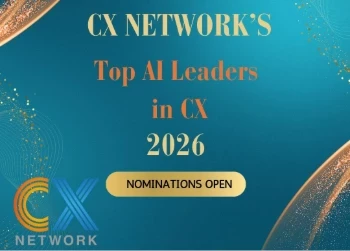Using generative AI to support emotive customer journeys
Why Totaljobs switched from human agents to a generative AI-powered assistant
Add bookmark
Whether it’s a mortgage application or online roulette, many customer journeys are highly emotive and demand that organizations have empathetic and enthusiastic service agents on hand. However, there’s a problem with depending on humans to be empathetic and enthusiastic – they get tired.
At Totaljobs Group, head of product Somnath Biswas, pioneered the AI Job Search Companion, a generative AI model designed to support job hunters through one of the most emotional and lonely user journeys that exists.
In this interview, Somnath talks to CX Network about supporting customers, AI ethics and the future of generative AI search. If you want to know more, click here to catch up with Somnath's interview at All Access: The AI Revolution in CX.

Don't miss any news, updates or insider tips from CX Network by getting them delivered to your inbox. Sign up to our newsletter and join our community of experts.
CX Network: The Totaljobs use case is a great UX story. What can those in CX learn from what you have achieved with generative AI search?
Somnath Biswas: The learnings for CX boil down to the two main reason why we started going down the conversational route: there is always an element of emotion involved that you need to recognize and account for, and conversation leads to better information, which leads to a better experience.
The emotion element is definitely true for job search and also true for most other journeys; whether you are applying for a bank loan or a job, there is an element of inherent emotion involved in that online experience.
A job search is a life-changing event, there is a lot of stress, you will apply for a job a hundred times and 99 times you will be rejected, but you still stay at it. The reason why we wanted to go down the conversational route is because we wanted to recognize and account for that emotion part of it.
From a CX perspective, if you can bring in this element of emotion, that makes the experience a lot richer.
The second part is also true to all journeys: a good conversation leads to better information, which leads to a better experience. In 2016, if you had a lead generation form, the conversion ratio was around 1.5 to 1.6 percent in terms of people filling up a form.
Whereas, if you have a chatbot on the other side and you are having a conversation, that conversation ration increased to as much as 13 to 15 percent. Why is this? It's because it's an incremental experience. You give me an answer, I build on it, then I build on it, and then you are almost kind of drawn into a conversation.
If you ask a question, people have a tendency to answer as opposed to having the cognitive load of “here's an entire form that I have to fill up”.
If you deliver the experience of having a good conversation, you get a lot more details about the user, which you can then build on in terms of better data, so the matching, recommendations, and ultimately the user all then benefit.
CX Network: When working with human agents, one of the greatest challenges is that their enthusiasm can wane after several transactions, whereas generative AI does not face the same emotional exhaustion. How did you humanize that emotional enthusiasm to make it appear genuine?
Somnath Biswas: It’s all about the right prompts. Many times, we actually see the model can get over excited as well, so it is also about balance.
initially started out with, and there is no right or wrong answer to it, it's basically, you have to kind of keep auditing it just like any other ML model, and you have to kind of make sure that your prompts indicate that you're being friendly, but you don't want to be extra friendly so that you come across as creepy as well. So you're basically trying to kind of bring it up.
So there are times when the model would kind of, because it has a prompt to say that, be friendly and be useful and be supportive, it might have a tendency to overuse the individual's first name. So it'll basically start off with, you know, Mel, this is the case, and Mel, you should do this and this thing, which is not the natural way of doing it.
We have an in-house team of conversation experts who kind of on a regular basis audit it for things like naturalness and empathy.
If we see things are becoming less natural after a release, we will then relook at our prompts and tweak it, so that we are getting to the right level.
The model itself by nature, by definition, it has the ability to bring in emotion at times. It understands all emotions, and it can understand sarcasm, but it is basically the degree of emotion that you wanted to display that needs to be managed through the actual writing of the prompts and the examples that you presented.
CX Network: When we conducted our 2024 research into the Global State of CX, 65 percent of practitioners either agreed or strongly agreed that their customers are concerned about ethical AI and the future development of AI for CX. How do you ethically design an empathetic, generative AI virtual assistant that meets these customer needs?
Somnath Biswas: We have an in-house team who are exclusively focused on ethical AI and we have been working very closely with them to make sure that any kind of bias are addressed. From time to time, we actually work with external experts as well.
At Totaljobs, we are in the early stages of building a product and from that perspective, we have made sure we are GDPR and EU AI act compliant, but equally things like bias, toxicity, making sure that from an accessibility perspective, the conversation is equally helpful for people who are differently abled… these are the core aspects that we have accounted for.
Compared to other conversational journeys out there, we have been more diligent. If you don’t get that right in the initial stages of the product, and try to bring ethics in afterwards, it isn’t very effective. Right from the very start, we had a defined frequency and we benchmark naturalness and empathy, but we also check for bias, toxicity, hallucination, and all these other aspects.
Ethical AI design comes down to getting the model to do what you want it to do; the prompt engineering, the kind of responses you are providing it in the examples so that it knows that when presented with this, this is the right way to do it.
Within the prompts, you are also providing the guardrails so the machine knows which ones to respond to, which ones not to respond to, which ones to sidestep.
It is incredibly powerful technology; what we build now will form the basis for what we build in the future. That means we have to bring in ethical AI now.
And this is where the future is bright for AI. If we are building these models to be inherently ethical, we are actually almost stamping out the bias. Five or six generations from now, people will not have any information that is biased, because all the information is going to come from the likes of the ChatGPT, which inherently is not biased. It is going to come from our responses, which are not biased. Eventually we will probably erode all the biased information that exists.
If you can basically make sure that any information being provided, any response being provided from here on does not have bias included, accounts for accessibility and accounts for inclusivity, then you are almost creating that new wave going forward.
So this is a chance to reset as well.
CX Network: Accessibility of contact channels was also highlighted as a CX priority by our Global State respondents. How can AI help in this respect?
Somnath Biswas: Generative AI allows for accessibility, because it's multimodal.
Now, it is not just a text that someone has to read. You have the ability to use voice should the use case require it; you have the ability to present a pictorial view should the use case require it. The very fact that technology now makes multimodal experience better inherently supports that drive towards accessibility because now it is that much easier.
It supports inclusivity as well, even in terms of languages. Not everyone is comfortable with English, but now you have models which are equally comfortable with multiple languages.
We are trying out some experiments basically using different languages to try and see if that impacts. But now with the technology that we have, it is that much easier. It is basically more of a choice, question of choice in terms of capabilities that exist.
Better technology will inherently drive towards a more inclusive, more accessible world. I think that's definitely in the DNA.
CX Network: What is your outlook for the development of generative AI for user experience?
Somnath Biswas: We will definitely have multimodal experiences. It will not just be text, it will become text to voice, video, multimedia included.
You will also see a lot of experiences getting personalized from a language perspective. If I prefer to speak in French or Spanish, I will have the option. I can switch.
Then I also think we will see smaller models being released. Like edge computing, you could probably see local AI models as well. This could be in your handheld device, and it will have all the information, meaning from a data privacy perspective, it is not leaving your device, but it is making your experience that much more personalized. There are a number of small models emerging, which are equally powerful.
The last piece is you will probably also see very domain specific models emerge, models which are specialist, like what Microsoft is trying to do with Copilot for finance and Copilot for sales, et cetera. After these very domain specific models also emerge, ultimately, it is probably going to be a one common model, which basically then calls other expert models to kind of get your tasks done. Then you will see domain specific fine-tuned models.
CX Network: What are your words of wisdom for CX practitioners who want to get to grips with AI?
Somnath Biswas: My only advice would be to not rush into AI – it is not the answer for everything.
There are some problems where simpler, cheaper solutions exist. AI is, if you're doing it properly, incredibly difficult and incredibly expensive, as well.
As I keep telling my team and we follow it, whilst we are AI first and LLM first, we are not AI only or LLM only.
Keep your eyes on the CX metrics, keep your eyes on the business metrics. If AI is the best way to move the needle, fantastic, go for it. But also look for other solutions that exist because there might be a simpler way to do it.
All Access: Future of CX 2025

Join us to hear from industry leaders, innovators, and CX experts as they share insights, strategies, and tools for harnessing customer feedback to drive meaningful change.
Register Now

























